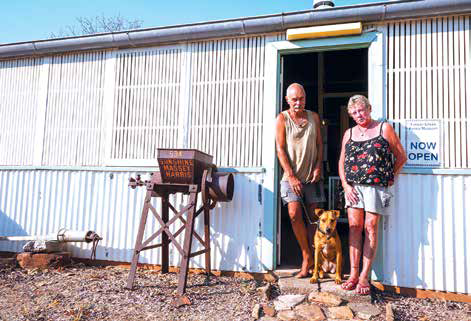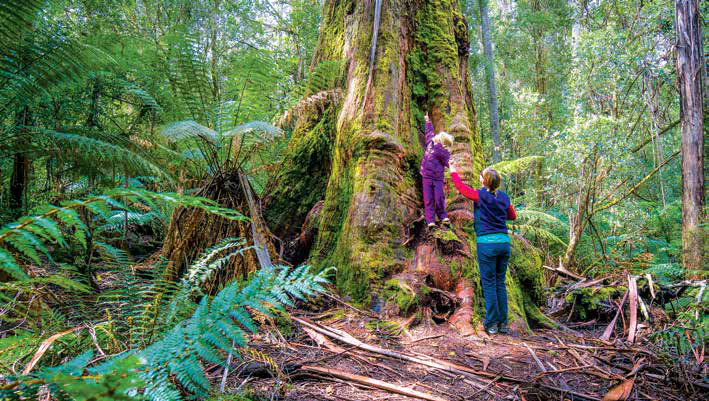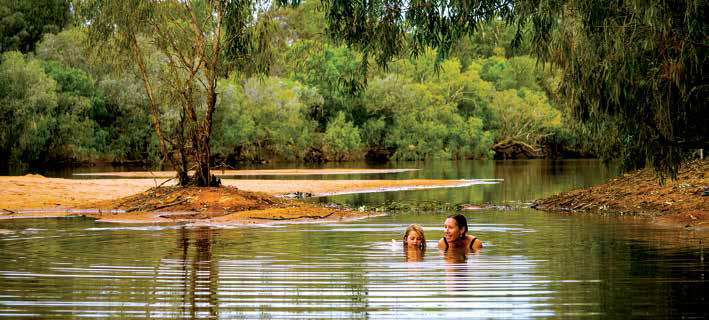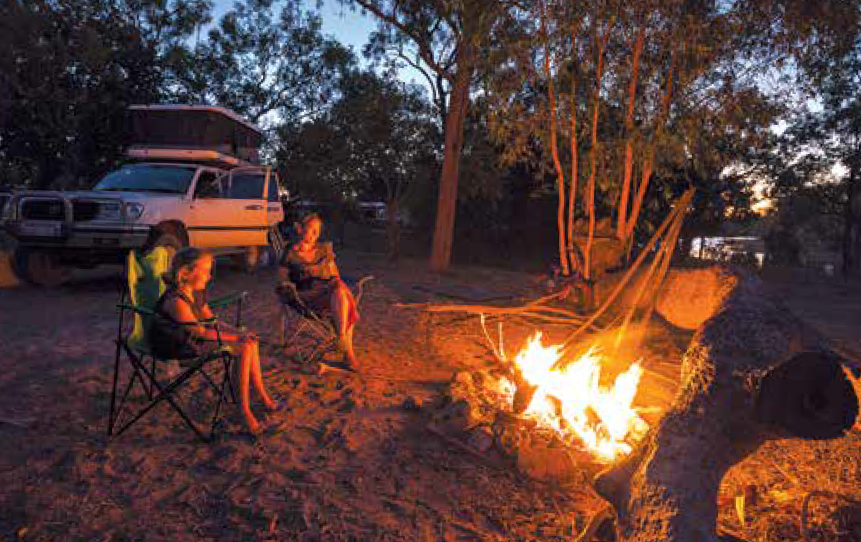
A trek to Everest Base Camp with Maya
Everyone dreams of escaping, of ditching the workday routine and living every day like it’s the weekend. It’s what drives so many Big Lap dreams and holiday road trips, because when your ‘to-do’ list starts with putting the solar panels in the sun, setting the crab pots and finding a sunny spot to sip your cuppa, you know you’ve got your life back on track.
More and more Australians are swapping mortgage stress and hectic living for a simpler, less hurried and much cheaper slice of the good life. But how do you make the holiday last and if you never went back home again, what might your life look like?
If you could create a life off the grid, living footloose and mortgage-free, where would you go and what would you miss?

Outback caretakers are always in high demand
My version of the dream began 20 years ago with a backpack and a budget campervan. Four sailboats and a handful of LandCruisers later I’m a fully-fledged digital nomad, living with my family entirely off the grid. Aboard our catamaran we pay no rent, make our own power and water daily, and travel year-round, schooling our eight-year-old daughter along the way.
It’s an adventurous life for sure, fuelled by wanderlust and our trio’s tight family bond, but having a sailboat anchors us in between journeys far afield in our 4WD and on touring bikes, between paddling trips and high-altitude hikes too.
Years ago, long before the ‘van life’ craze took hold and people started working from home, our nomadic lifestyle was deemed to be very much on the fringe. Today, most people I meet would be thrilled to carve out a life on that fringe and never return to office desks, deadlines and commuter traffic.
Escaping the grid is easier than you might think and here’s how it could happen for you.
SELF-SUFFICIENT LIVING
Whether you are living on a boat, in an RV, or on a remote patch of wilderness, when you live off the grid, self-reliance is everything. On the boat, we get our power from a wind generator and a rooftop of solar panels (2 x 80W, 2 x 120W, and 1 x 40W panel), all feeding our 440Ah battery system. With that we power a fridge, freezer, lights, fans, marine toilet, our navigation and communication system, and our laptops and work gear.
When the sun doesn’t shine and the wind doesn’t blow, we pull back on our power usage and as an emergency, kickstart the generator. We don’t run a lot of whitegoods: there’s no microwave or electric kettle, no hair dryer, breadmaker or coffee maker, and the dishwasher is whoever didn’t cook that night. I was recently gifted a small electric washing machine that the solar panels power on sunny days and I love it!
Wet season downpours are channelled from our sailboat roof into four 100L tanks, and a small desalination unit keeps our drinking water topped up throughout the dry season. We catch fish, process and freeze fresh fruit and veggies when they are plentiful and cheap, and nurture a small onboard garden of lettuce, spinach and herbs to keep our iron levels high at sea.
When travelling on the road our life is even more basic: a 4WD with a rooftop tent, camp chairs and a roaring fire, bush toilets and infrequent showers. Twenty years of necessity has turned us into bush mechanics and there are few repairs we can’t tackle if we have to. That means that our ‘bosuns locker’ aboard is a mini-workshop full of everything we need to make emergency repairs, often at sea.

Another digital nomad hard at work, wilderness photographer David Bristow
SUPPLIES APLENTY
As every RVer knows, packing for each adventure is a juggling act between what you truly need on board, the things you want to take, and the spares and repairs you might need if something goes wrong in a faraway spot.
So you pack a little of everything — clothes, books, kitchen gear and outdoor toys — and wonder after you’ve left the rest behind for months on end, if you really need so much stuff at all. That’s what drives our minimalist approach to living, so we consciously choose to buy and keep only what’s really important or useful.
We travel with no more than we can fit into our backpacks or bicycle panniers or the back of the 4WD, and our family and friends know that the birthday gifts we treasure most are the things we actually use: clothes, camping gear, books and vouchers.
It takes a certain mindset to be truly happy with less, but we’ve learnt over time that our child doesn’t need an excess of toys or books or games. Instead, she owns a slender array of toys and sports gear for fishing, biking, surfing and snorkelling, plus books and craft supplies. Like all travellers, space dictates that we resist buying more than we truly need.

Packing for the next adventure is always a juggling act
WHEN THINGS GO WRONG
Before our last sailing adventure from Cairns to Darwin, my GP showed me how to suture a wound, and I poured over a copy of Where There Is No Doctor and hoped for the best. At sea and out of radio and phone range, we were truly on our own and far from help if we could get to it at all.
We routinely sailed for weeks without ever seeing another boat and although no accidents occurred this time around (huge sigh of relief), I was acutely aware and at times anxious that my first-aid skills would be called upon should anything go wrong. Having a child on board intensifies the worry so safety becomes paramount and few tasks are tackled without considering the consequences.
Every burn, cut, sprain or illness must be managed on board, with often very long distances to sail or motor to get help if needed. A few years ago while sailing Cape York, I managed to stick my finger into a hand blender and with medical help a couple of days’ sail away, had to piece it back together myself with suture strips and a heavy dose of painkillers.
On the road, help is far closer at hand — but outback travellers are not immune from the difficulties and delays of accessing medical or mechanical help in remote locations. The only real insurance to surviving accidents off the beaten track is to know first-aid and vehicle mechanics.

Learning is a natural part of life when you travel with kids
BECOMING A DIGITAL NOMAD
You may have already made your money and retired to the easy life, but for most people, the need to work won’t stop just because you’ve escaped the rat race.
I was already a travel journalist when I met my partner — wilderness photographer David Bristow — so working together was a perfect match. We created wildtravelstory.com, an information hub for adventurous travellers, and when our daughter Maya was born, we brought her home to catamaran number three.
Barely four weeks later we embarked on Maya’s inaugural Big Lap to write our first book Highway One, and two passports and eight years later, she has joined us on an endless journey of adventure and family fun. We make it pay by writing and photographing for magazines, by producing travel guides and books, and contributing to websites too.
Not everyone wants to start a blog, but if they are unique enough, you can make them pay. Hundreds of careers that have gone digital in the last decade, and I’ve met loads of people working from caravans and campsites, hotel rooms, island bungalows and boats: web designers and share traders, advertising copywriters, educators, and all kinds of suppliers selling their wares from online stores.
Work and travel are surprisingly compatible so if the idea of working from afar interests you, talk to your employer and try to negotiate a way to continue your usual job (or parts of it) while travelling. If a laptop and phone are your main tools, and you can connect with clients, customers and co-workers via Skype or FaceTime, there is no end to how far away your office can be.
If being a digital nomad isn’t your thing, it may be time for a second career. The key is to know your niche — what you do well — and spend time learning skills and developing a business idea that you can take anywhere. It might be something creative, such as jewelry making or painting, online teaching, consulting or selling.

Barely four weeks old and tackling her first Big Lap
When you make the leap, find low-cost locations to work from with a good internet connection. Stay on top of trends: just because you are away from the water cooler doesn’t mean you can afford to be out of touch.
Stay motivated too. The flexibility of working your own hours is fantastic but when there’s work to be done, only you can get yourself out of bed to meet deadlines (even if you are working in your PJs).
Lose the working week mentality fast. Work weekends if you want to or late nights when you can’t sleep. Your out-of-office flexibility will become one of your greatest assets as a digital nomad. Finally, never undersell yourself. Just because your living expenses are low, doesn’t mean you have to work for peanuts.

Maya and I take time out from work for a dip at Litchfield National Park
MAKING IT PAY
If becoming a digital nomad doesn’t appeal, you’ll find short-term, seasonal and relief jobs aplenty in remote areas where communities are hungry for skilled workers. I’ve met travellers working as locums, filling maternity or parental leave vacancies, or giving owner-operators a well-deserved, off-season break from their roadhouses, remote holiday resorts, small-town motels or caravan parks (one happy couple renting canoes at Adels Grove was the envy of our Lawn Hill campground).
If you only want to cool your heels for a month or two in a new, beaut location, look for a seasonal gig in retail and hospitality, help bring in the harvest (it’s a fruitful way of earning an income) or join Outback Helpers Scheme and be paid in cash or kind for assisting on an Aussie farm or station. If your rig is set up to power itself, you can live rent-free, off the grid too.
WORLD SCHOOLING KIDS
Kids make excellent travellers. They are flexible and far more adaptable than we give them credit for. You can squeeze them into the campervan dinette to sleep, skip a shower when you don’t have enough water, feed them sandwiches for dinner and put them to bed by torchlight. When things are new, there’s great potential for fun.
Having travelled with our curious little kid since she was four weeks old, learning is a natural part of life. It happens every day in unexpected ways and every new environment — at home and overseas — becomes a fresh canvas to explore.
For the last three years we’ve followed the Australian curriculum, but how we tackle our lessons is structured to the places we visit and the experiences we have. Like work, lessons can happen on beaches, in the bush, while paddling or sailing or driving in the car. It’s flexible, usually fun and individually tailored to the way my daughter learns best.
Because we are always on the move and because changing time zones and unreliable internet complicates class-based learning, Distance Education isn’t an option. Instead, I design my own curriculum and lessons and report directly to the Queensland Home Education Unit. So far it works and I’m learning to teach, too.

At sea and out of radio and phone range, self-reliance is everything
LIFE ABOARD
Living on a boat is not always easy. The sea can be rough, the wind might dissipate altogether, and there are tropical cyclones to endure, squalls to dodge and reefs to avoid. Anchoring is never as easy as parking the camper, and the headwork of navigating, steering, predicting weather and keeping everything running can easily do your head in.
We live in each other’s pockets in a very cosy space and our boat’s bridge deck transforms hourly from a dining space to an office to a kids’ playroom depending on the time of day.
But, and it’s a very big but, life at sea makes me smile. When the winds are favourable we can sail off on a whim, and we do: from Cairns to Darwin and Indonesia before the year is over. We throw down our anchor off the most idyllic tropical islands – coral-fringed, utterly uninhabited and all our own. We catch barramundi and Spanish mackerel and tuna as we troll, stoke beachside campfires, watch every sunset and beachcomb for enormous, rarely seen shells.
Yes there’s water to make and school to teach and frustratingly dodgy internet in remote destinations, but we adhere to no schedules, pay no rates, rent or power bills, and every day is an adventure.

A roaring fire is sometimes all you need
Category: Features
Written: Tue 01 Oct 2019
Printed: October, 2019
Published By: